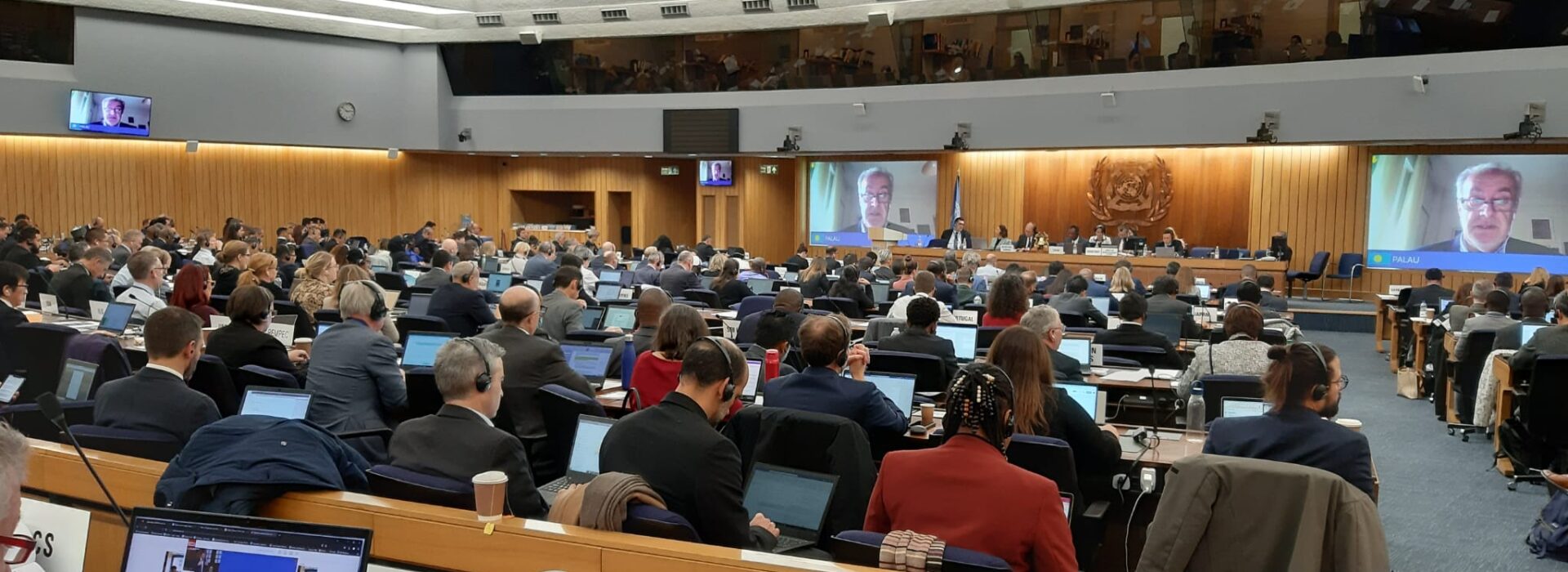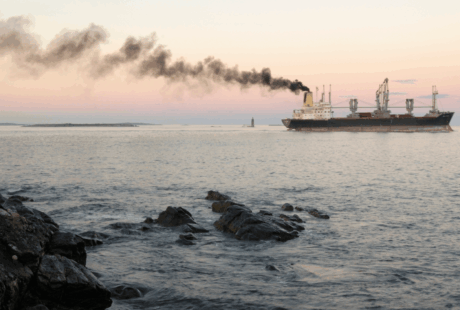You can download the explainer here.
Summary: Key Guardrails at a Glance
| Guardrail | Purpose |
| Limit carbon trading | Prevents pay-to-pollute dynamics, supports real reductions |
| Price RUs above decarbonization cost | Ensures companies choose real emissions cuts over shortcuts
|
| Prioritize and reward ZNZ fuels/tech | Accelerates adoption of sustainable alternatives
|
| Reinvest penalty revenue | Supports a just transition through global infrastructure funds
|
| Stabilize markets to protect food systems
Limit SU banking |
Reduces unintended impacts on vulnerable economies
Avoid frontloading available SUs in early years |
Context:
The Two-Tier GHG Mechanism – Explainer and Guardrails
The two-tier mechanism now under discussion following ISWG 19 (31 Mar – 1 Apr, 2025), while not a universal greenhouse gas (GHG) pricing mechanism, has the potential to drive continuous emissions reductions if its parameters are carefully designed. However, to ensure as much of a fair transition and long-term effectiveness as possible within this reality, several key factors must be addressed, particularly limiting GHG emissions trading, setting an appropriate price for remedial units (RUs), and ensuring real incentives for zero and near-zero (ZNZ) fuels and technologies.
This document explains how the two-tier system works in practice and outlines critical guardrails to enhance fairness and effectiveness.
How the Two-Tier System Works
The system operates with two levels of GHG Fuel Intensity (GFI) targets. The GFI target is a ceiling that sets the maximum allowable greenhouse gas emissions per Megajoules.
What is a GHG Fuel Intensity (GFI) Target in This Context?
In the Two-Tier GHG Mechanism, a GHG Fuel Intensity (GFI) target defines the maximum allowable greenhouse gas emissions per unit of energy used — specifically measured in grams of CO₂-equivalent per megajoule (gCO₂e/MJ) of fuel consumed.
What It Means in Practice
- It measures how “clean” the energy used by a ship is, based on the climate impact per megajoule of fuel energy.
- The lower the GFI, the less carbon-intensive the fuel or propulsion system.
How It Works in the Two-Tier Mechanism
Tier 2 – Base Target A general emissions reduction target applied to all ships. Promotes continuous improvement of energy GHG intensity.
Tier 1 – Direct Compliance Target A stricter emissions target. Ships that exceed this benchmark receive Surplus Units (SUs) that can be banked, transferred, or sold.
Compliance Process
At the end of each reporting period, a ship calculates its Attained Annual GFI and compares it with its Target Annual GFI. If a ship fails to meet its targets, it must offset its emissions deficit through one or more of the following compliance options:
- Using banked Surplus Units (SUs) earned in previous years or transferred from compliant ships.
- Participating in a compliance pool, where ships in a fleet share Surplus Units.
- Purchasing Remedial Units (RUs) from the IMO at a fixed, pre-determined price if no surplus credits are available to that ship. Tier 1 RUs are priced lower than the Tier 2 RUs.
Over time, compliance becomes stricter, increasing penalties and guiding the industry toward cleaner alternatives.
Over time, targets become more stringent to guide the industry toward cleaner fuels and technologies.
Three Practical Scenarios
Scenario 1: Ship Meets the Direct Compliance Target
A state-of-the-art vessel running on wind propulsion and e-fuels.
The ship’s attained GFI is better than the Direct Compliance Target (Tier 1).
Outcome: The ship earns Surplus Units (SUs), which can be:
- Sold to non-compliant ships, and potentially used within a compliance pool.
- Banked for future use.
Why This Matters
– Encourages early adoption of zero and near-zero (ZNZ) fuels and technology by rewarding clean operators.
– Reduces long-term compliance costs for companies that proactively invest in sustainable shipping.
Key Guardrail
To reduce market uncertainty and prevent excessive trading, Surplus Units should be limited within and across tiers
Scenario 2: Ship Meets Base Target but Not the Direct Compliance Target
Example: A conventional ship using transitional fuel with efficiency improvements.
The ship meets the Base Target (Tier 2) but not the Direct Compliance Target (Tier 1).
Outcome: The ship faces a Tier 1 compliance deficit and must:
- Use banked Surplus Units from previous years (if available).
- Purchase Surplus Units from another compliant ship.
- Pay for Remedial Units (RUs) from the IMO at the Tier 1 benchmark rate.
Why This Matters
– Ensures continuous improvement by gradually encouraging ships to transition to cleaner fuels.
– Allows flexibility while still imposing financial consequences for failing to reach Tier 2 compliance.
Key Guardrail
- Remedial Units (RUs) must be priced high enough to make direct investment in ZNZ fuels a more attractive option.
- The system should phase out transitional fuels (e.g., LNG) over time to avoid stagnation in decarbonization progress.
Scenario 3: Ship Fails to Meet Either Target
Example: An old, inefficient vessel running on heavy fuel oil (HFO).
- The ship faces both the Tier 1 and Tier 2 compliance deficit.
- Outcome: ships must:
- Purchase Remedial Units (RUs) from the IMO at a high cost.
- If RU are priced at both tier 1 and tier 2, then the ship must purchase:
- Tier 1 Remedial Units (RUs) at a lower benchmark rate to cover the first level of non-compliance.
- Purchase Tier 2 Remedial Units (RUs) at a higher cost to cover emissions exceeding the Base Target.
- Consider retiring the vessel or investing in emission reduction technologies.
Why This Matters
– Creates a strong financial disincentive for continued use of high-emission vessels.
– Ensures the worst polluters contribute the most to decarbonization efforts.
Key Guardrail
- Remedial Units (RUs) should always be more expensive than the cost of adopting clean technologies.
- Revenue from penalties should fund energy transition projects to promote a fairer transition.
Ensuring Fairness & Stability: Four Key Guardrails
Limiting Carbon Trading
Unrestricted Surplus Unit trading can allow high-emission ships to continue polluting if they can afford to buy compliance.
This:
- Delays real investment in green technologies.
- Creates market volatility, discouraging shipowners from long-term planning.
- Favours wealthier companies, putting smaller operators and developing nations at a disadvantage.
Solution:
- Cap the percentage of compliance that can be met through trading.
- Ensure Remedial Units (RUs) are always priced higher than direct decarbonization investments. This will help to ensure strong incentives for real emissions reductions.
- Limiting banking to a specific amount of time, one or two years for example
- limiting SU purchasing to ships fully noncompliant
Setting Effective RU Pricing
If Remedial Units are too cheap, ships may simply pay instead of reducing emissions.
Solution:
Use a dynamic up to date and regularly reviewed pricing model for RUs tied to the actual cost of decarbonization (linked to price of efuels).
Conduct regular reviews of RU prices to ensure they remain a strong deterrent.
Incentivizing Zero and Near-Zero (ZNZ) Technologies
Simply penalizing high-emission ships is not enough; the system must actively reward clean investments.
Solution:
Offer discounted Remedial Units (RUs) for early adopters of wind propulsion and e-fuels, could be taken on board.
Ensure revenues from compliance penalties are used to fund green infrastructure and innovation.
Protecting Food Security
Freight price volatility from carbon trading could impact global food prices, disproportionately harming vulnerable countries.
Solution:
Implement limits on credit trading to stabilize market conditions.
Conclusion
The Two-Tier GHG Mechanism presents a clear, scalable pathway toward decarbonization of the maritime sector. While it is not as comprehensive as a global levy, its success depends on thoughtful design and robust guardrails.
With the right safeguards in place, this mechanism can:
- Drive deep and lasting emissions reductions
- Encourage real investment in ZNZ technologies
- Promote greater equity across global shipping
- Avoid market distortions and food security risks
Posted on: 4 April 2025


